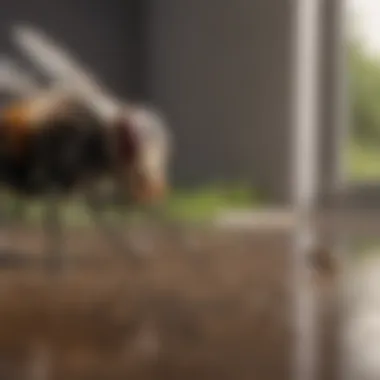Understanding the Rapid Increase of Flies in Your Home


Intro
Flies in the home can be more than just an annoyance. Their sudden presence can indicate deeper issues related to cleanliness and pest management. Understanding the factors contributing to an increase in flies is crucial for homeowners who strive to maintain a pleasant living environment. This article will delineate causes of fly infestations, provide methods for control, and emphasize the importance of identifying specific fly species.
Recognizing why flies invade our spaces is the first step toward effective prevention and management. By taking a proactive approach, individuals can create a fly-free home conducive to comfort and hygiene. In the following sections, we delve into key insights surrounding this topic.
Preamble to Domestic Fly Invasions
The presence of flies in a home can be more than just a nuisance. It can signal underlying issues that require attention. Understanding the dynamics of domestic fly invasions is essential for maintaining a comfortable living environment. Over the years, homeowner experiences with fly problems have shown that prevention and control methods vary significantly depending on numerous factors. This exploration into the topic serves to empower residents, enabling them to tackle infestations effectively.
This article delves into various causes of fly infestations, revealing how specific environmental triggers contribute to their rapid increase. An emphasis is placed on recognizing the types of flies commonly found in residential areas. By identifying species, homeowners can apply tailored solutions that address particular challenges these pests present.
Effective management of fly populations becomes a matter of adopting comprehensive strategies. It includes maintaining proper hygiene practices, assessing potential attractants within the home, and understanding the role that structural vulnerabilities play in these invasions. The integration of these elements not only mitigates current infestations but also acts as a preventive measure for the future.
Moreover, the importance of professional pest control services cannot be understated, as they provide expertise and resources that might be beyond the average household's capabilities. Seeking help when necessary ensures that infestations are handled promptly and effectively.
In summary, the introduction to domestic fly invasions serves as the foundational block for understanding how flies invade homes, the specific triggers that exacerbate these situations, and the comprehensive approach necessary for effective management. Recognizing the nuances of this subject can lead to improved living conditions and increased comfort in the home.
"Addressing fly problems is about knowledge and action. Insights on causes leads to practical solutions."
By unraveling these complexities surrounding flies, homeowners are better equipped to confront the issues they face, ensuring a cleaner and more pleasant living space.
Understanding Common Fly Species
Understanding common fly species is essential for any homeowner facing a sudden influx of these pests. Knowledge about different fly types can help in identifying their specific behaviors, habitats, and attractants. Different species have unique characteristics that influence how they can be controlled. Consequently, knowing them can lead to a more effective strategy to manage and reduce their populations in your home.
House Flies
House flies (Musca domestica) are perhaps the most common household pests. They are easily recognized by their gray bodies and four black stripes on their backs. These flies thrive in warm environments and are attracted to decaying organic matter, food residue, and waste products.
The role of house flies in the home goes beyond just annoyance. They can carry various pathogens and can contaminate food by transferring bacteria from waste to consumables. Regular cleaning and sanitation are key to managing their presence. If house flies are prevalent, it indicates poor hygiene concerning food sources or waste disposal.
Fruit Flies
Fruit flies, scientifically known as Drosophila melanogaster, are smaller than house flies and are often tan or light brown with red eyes. They tend to infest overripe or rotting fruits and vegetables. Because of their small size and rapid reproduction, fruit flies can quickly become a significant problem indoors.
These flies are usually found in kitchens, especially near fruits kept on the countertop. Preventive measures include proper food storage, regularly discarding old produce, and ensuring cleanliness in areas of food preparation. When they appear, it usually indicates a ripe fruit issue or leftover residues.
Flesh Flies
Flesh flies are attracted to decomposing organic matter, including carrion, animal waste, and garbage. They are grayish with a more robust body compared to house and fruit flies. While these flies are not commonly noted in indoor environments, their presence signals a serious issue, often relating to uncontained waste.
Being carriers of disease, flesh flies should not be ignored. It is essential to check for any underlying issues causing their presence and act immediately to correct waste management practices in your home.
Drain Flies
Drain flies, known as Psychoda spp., are small and fuzzy with a moth-like appearance. They breed in stagnant water, especially in drains, sewers, or any spot with standing water. Drain flies indicate that there is a moisture issue or that your drainage system requires cleaning. They are not harmful, but their presence shows a need for sanitation.
To control drain flies, regular cleaning of drains and fixing moisture issues is crucial. Consider using a mixture of vinegar and baking soda to clear out drains where they are frequently seen. This practice can reduce stagnant water and eliminate potential breeding grounds.
Exploring Environmental Triggers for Fly Infestations
Understanding environmental triggers for fly infestations is critical in managing and preventing the presence of these pests. Various elements within the environment can significantly influence fly populations. By identifying these triggers, one can effectively implement strategies to deter these insects from entering and thriving in residential spaces. Knowing how factors such as seasonal changes, temperature fluctuations, and humidity levels affect fly behavior can lead to better control methods.
Seasonal Changes
Flies are not present in the same numbers throughout the year. Seasons play a crucial role in their life cycles and population growth. Warmer months tend to see an increase in fly activity. For example, in late spring and summer, many fly species reproduce more rapidly due to favorable temperatures. During this time, houses often become more appealing due to the abundance of food sources and ideal breeding conditions.
Homeowners should be especially vigilant during these peak months to ensure cleanliness and proper waste disposal.
To mitigate the impact of seasonal changes:


- Trim vegetation around your property to reduce breeding sites.
- Seal entry points in home structures to prevent flies from finding shelter.
Temperature Fluctuations
Temperature not only affects human comfort but also influences the lifecycle of flies. Flies thrive in warm temperatures, with most species' activity peaking between 75 to 85 degrees Fahrenheit. In particularly hot weather, the reproductive rate may increase significantly. Conversely, cold weather can reduce fly populations but not eliminate them entirely. Some species can survive extreme temperatures in egg or larval forms before re-emerging when conditions become favorable.
To prepare for temperature impacts:
- Maintain a consistent indoor temperature to discourage fly activity.
- Use air conditioning strategically to keep homes less inviting for flies, especially in warmer seasons.
Humidity Levels
Fly infestations are also influenced by humidity. High humidity creates a conducive environment for breeding, especially for species like fruit flies and drain flies, which thrive in moist conditions. Environments with dampness present a greater risk because they often have stagnant water sources that can be breeding grounds.
Homeowners can minimize issues related to humidity by:
- Keeping bathrooms and kitchens dry.
- Fixing leaks in plumbing to eliminate potential breeding sites.
"Managing humidity in your home is essential to discourage fly infestations."
By understanding how seasonal changes, temperature, and humidity affect fly behavior, property owners can take proactive steps. This knowledge empowers one to not only address current infestations but also prevent future invasions.
Identifying Attractants in the Home
Identifying what attracts flies into your home is vital for managing their populations effectively. House flies, fruit flies, and others are drawn to specific conditions and items within your living spaces. Understanding these attractants not only helps in recognizing the problem but also allows you to adopt smarter strategies to prevent infestations. When homeowners address these attractants, they create a less inviting environment for flies. This, in turn, fosters a more pleasant living space.
Food Sources
Flies are, by nature, opportunistic feeders. They tend to swarm around food sources, especially those that are often left uncovered. Fruits, vegetables, and leftovers sit atop the list. When considering how to prevent fly invasions, addressing food storage practices becomes crucial.
- Cover food items: Always use lids or wraps for food items.
- Prompt clean-up: As much as possible, clean up spills and crumbs quickly.
- Food storage: Keep food in airtight containers. Flies can detect food even from a distance, so make sure everything is secured.
In essence, consistent management of food sources can significantly deter flies from entering your home.
Trash and Waste Management
Improper waste disposal plays a central role in attracting flies. Garbage cans and compost bins can be breeding grounds if not managed correctly. Regular maintenance of trash areas is essential. Consider these points:
- Seal trash: Use bins with secure lids to minimize scent.
- Empty regularly: Dispose of trash at least once a week.
- Clean spills: Wipe down the insides of trash bins periodically.
- Composting practices: Ensure compost piles are turned frequently and covered to avoid odors.
By implementing effective trash and waste management, homeowners can address a significant attractant and potentially reduce their fly population.
Pet Waste
Pet waste can be another significant attractant for flies. Dogs and cats generate waste that, if left unattended, can lure flies. Here’s how to manage this issue:
- Immediate cleanup: Clean pet waste as soon as possible. The longer waste remains, the greater the chance of attracting flies.
- Designated areas: Train pets to use specific areas for their needs, making cleanup easier.
- Regular yard maintenance: Inspect and maintain outdoor spaces to avoid build-up.
Hygiene Practices to Prevent Flies
Effective hygiene practices are essential when dealing with fly infestations. Flies are attracted to unsanitary conditions, and their presence is often a direct result of poor cleanliness. By implementing diligent hygiene routines, homeowners can significantly reduce the likelihood of a fly invasion. This section discusses the key components of hygiene practices that support fly prevention.
Regular Cleaning Routines
Maintaining a consistently clean living space is fundamental in minimizing fly attractants. Regular cleaning routines should include:
- Daily surface cleaning: Wiping down countertops and tables can eliminate leftover food residues that attract flies.
- Vacuuming and sweeping: These activities help remove crumbs and small debris, which are food sources for flies.
- Focus on hidden areas: Places like behind appliances or beneath furniture should not be overlooked, as flies can breed in these scarcely cleaned spots.
Implementing a cleaning schedule can create a sustained hygienic environment. If this is neglected, flies can multiply quickly, making it harder to manage the population.
Proper Food Storage


Proper food storage plays a crucial role in preventing flies. Food should be stored adequately to avoid attracting these pests. Key practices include:
- Seal all food items: Using airtight containers can prevent flies from smelling and accessing food.
- Refrigeration: Perishable food must be stored in the refrigerator to deny flies a breeding ground.
- Redirect attention to fruits and vegetables: Keep them in the refrigerator rather than exposed on countertops, especially during warm weather.
Adopting these food storage methods can drastically limit fly access to food sources, making it less likely for populations to thrive within your home.
Quick Waste Disposal
An effective waste disposal routine is vital in the fight against flies. Flies are drawn to smells, and stagnant waste can become a breeding ground. Recommended practices for waste disposal are:
- Take out the trash regularly: Ensure that trash bins are emptied frequently, particularly in hot months when decomposition speeds up.
- Use bins with tightly fitting lids: This helps contain odors and prevents flies from getting in.
- Compost correctly: If you compost, ensure that it's managed properly. Keep it covered and aerated to avoid attracting flies from organic waste.
Implementing these waste disposal techniques can minimize odors and unsightly messes, thus deterring fly populations from entering your living space.
Remember: Flies thrive in environments rich in food and waste. Maintaining hygiene is not just about cleanliness but is a direct method to combat these pests.
Evaluating Structural Vulnerabilities
Understanding structural vulnerabilities in your home is crucial for effectively managing fly populations. Flies can exploit even the smallest openings, making it essential for homeowners to evaluate their properties for potential weaknesses. By addressing these vulnerabilities, one can significantly reduce the chances of an infestation and create a more comfortable living environment.
Screening and Sealing Openings
Openings such as windows, vents, and doors often serve as gateways for flies. Installing screens can be an effective way to keep them out. These must be in good condition, without holes or tears. In addition, sealing gaps around windows and door frames prevents flies from finding their way inside.
It is also important to assess the condition of your screens regularly. Minor repairs can keep doors and windows secure. Remember that any overlooked opening might be an invitation to flies.
Benefits of Screening and Sealing Openings:
- Provides a physical barrier against pests.
- Helps in overall house maintenance.
- Reduces the need for chemical interventions.
Assessing Entry Points
It is not only openings but also entry points that require examination. Flies are attracted to specific areas in and around your home. These points often include gaps in walls, cracks in foundations, or holes around plumbing fixtures.
Any structure should be checked regularly for these vulnerabilities. Observation plays a big role in this regard. For instance, if a corner of your garage seems prone to moisture collection, it may be providing flies with an ideal environment to breed.
When assessing these entry points, take note of the following key considerations:
- Location: Examine areas close to compost bins or gardens, as they may attract flies.
- Accessibility: Consider how easily flies can enter through discovered gaps.
- Maintenance: Regularly maintaining the exterior can decrease the likelihood of fly access.
By effectively screening and sealing openings while assessing entry points, homeowners can implement practical solutions to deter flies. This process minimizes the draw they have toward your living spaces, fostering a more pleasant atmosphere.
Control Methods for Fly Populations
Dealing with flies requires a strategic approach. Understanding control methods is essential for minimizing fly populations in your home. The choices range from using traps to applying natural solutions and chemical insecticides. Each method has its benefits and considerations that homeowners must be aware of, particularly regarding safety and effectiveness.
Commercial Fly Traps
Commercial fly traps can be an effective tool in managing fly infestations. These traps are designed to attract and capture flies, offering a practical way to reduce their numbers. Different types of traps are available, including sticky traps, electric traps, and baited traps. Each type operates in a specific manner. Sticky traps are useful for monitoring fly activity, while electric traps can annihilate flies on contact. Key benefits include:
- Immediate results with reduced fly activity.
- Specific targeting of fly species.
- User-friendly operation with minimal ongoing maintenance.
When selecting a commercial fly trap, consider the area you wish to protect. Larger spaces may require multiple traps to be effective. It's also important to maintain the traps regularly to ensure they remain effective over time.
Natural Repellents
Natural repellents offer a less aggressive way to deter flies. Many homeowners prefer these options to avoid chemicals around their living spaces. Ingredients like eucalyptus oil, peppermint oil, and vinegar can naturally repel flies. These can be used in various forms, such as sprays or essential oil diffusers. Considerations include:
- Less toxicity to humans and pets.
- Sustainable and environmentally friendly alternatives.
- They may require frequent application for effectiveness.
To create a simple natural fly spray, mix a few drops of essential oil with water in a spray bottle. This can be sprayed around windows and doorways to keep flies at bay, although it may not eliminate them completely.


Insecticides
When natural methods fail, insecticides can provide a more aggressive response. These chemical solutions are effective in reducing fly populations swiftly. Household insecticides come in various forms: sprays, foggers, and granules. While they can yield quick results, several important factors must be taken into account:
- Always follow label directions for safe application.
- Consider the potential impact on pets and children.
- Regular treatment may be necessary to maintain efficacy.
Many insecticides target specific types of flies, ensuring that they are effective against the most common culprits in homes. Using insecticides in conjunction with other control methods can enhance overall effectiveness, creating a comprehensive fly management strategy.
Proper identification of the prevalent fly species can significantly influence the choice of control method.
The Role of Outdoor Environments
The outdoor environment plays a critical role in the dynamics of fly populations, greatly influencing the occurrence of infestations within homes. This section will delve into how various external factors contribute to attracting flies inside and what can be done to manage their prevalence. By understanding these relationships, homeowners can make strategic choices in their outdoor spaces to decrease the risk of fly invasions.
Landscaping Considerations
Landscaping significantly impacts the presence of flies around residential areas. A well-maintained yard can deter many pests, including flies, while poorly managed spaces can become breeding grounds for these insects. Here are key landscaping considerations to keep in mind:
- Overgrown Vegetation: Tall grass, dense bushes, and wildflowers can create habitats for flies and their breeding sites. Regular trimming and maintenance can reduce their numbers.
- Standing Water: Accumulated water from overwatering, poor drainage, or even decorative ponds can attract flies, especially mosquitoes and other breeding species. Ensure that water does not collect in any areas.
- Use of Repellent Plants: Certain plants, like marigolds and basil, may repel flies. Incorporating these into gardens can serve as a preventive measure.
- Sunlight and Airflow: Keeping yards open and well-lit can discourage fly populations. Flies prefer darker, more humid areas. Therefore, encourage sunlight penetration and airflow in your landscape layout.
These landscaping choices can make a notable difference in your home’s overall fly presence.
Waste Management Outside the Home
Proper waste management outdoors is essential for reducing fly attraction. Flies are notorious for gravitating towards waste, and neglecting this area can lead to serious infestations. Important practices include:
- Regular Trash Collection: Ensure that trash cans outside the home are emptied regularly and have tight-fitting lids. This minimizes odors that attract flies.
- Compost Management: If composting, maintain it properly. Flies are drawn to decomposing organic material. Turning the compost and covering it can help mitigate this issue.
- Pet Waste Removal: Pet waste can draw flies if not disposed of quickly. Automatic clean-up routines can prevent waste accumulation that would attract flies.
- Recycling Practices: Before putting out recyclables, rinse them to remove any food residue. Dirty containers can become a target for flies, especially after being in the sun.
Maintaining a clean exterior environment is as important as the interior in managing fly populations effectively.
By addressing these outdoor elements, homeowners can create less hospitable environments for flies, contributing to a more comfortable living space within their homes.
The Importance of Professional Pest Control
Dealing with a fly infestation can be overwhelming. These pests are not just a nuisance; they can also pose health risks. Professional pest control services are crucial in managing fly populations effectively. When infestations exceed a homeowner's control capabilities, enlisting experts becomes essential. Professionals have access to advanced tools and specialized knowledge that significantly improve the chances of eradication.
The success of pest control is dependent on accurate identification of the fly species. This is where professionals excel. They know how to distinguish between types of flies, which helps tailor the treatment approach. Understanding the specific fly species involved allows for targeted solutions. This method is often more effective than generic treatments that might not consider specific behaviors.
When to Seek Professional Help
Homeowners should consider contacting a pest control professional when basic DIY methods fail. If flies continue to appear despite efforts like cleaning and sealing entry points, it may signal a more significant problem. Signs of persistent infestation include:
- Large numbers of flies congregating in one area.
- Breeding sites found indoors or outdoors within the home.
- Persistent odors that could indicate dead flies or larvae.
Additionally, for those living in regions with warm climates, the chances of fly infestations increase during the summer months. In such cases, it is wise to seek help even before an infestation spirals. Acting quickly can prevent a minor issue from becoming a major problem.
What to Expect from Pest Control Services
When homeowners decide to use professional pest control services, it is essential to understand what to expect. The process typically involves several key steps:
- Initial Assessment: Pest control experts will assess the situation by inspecting the home. They will look for fly species and breeding sites.
- Customized Treatment Plan: Based on the assessment, they'll develop a tailored plan addressing the specific needs of the infestation.
- Implementation: Professionals will apply treatments, which can include traps, sprays, or baits designed to eliminate flies effectively.
- Follow-Up: Many services offer follow-up visits to monitor the situation and ensure continued effectiveness of the treatment.
By working with professionals, homeowners can benefit from a more comprehensive and effective approach to managing fly populations. This not only provides peace of mind but also helps secure a healthier living space.
Finale: Managing Fly Populations Effectively
Managing fly populations effectively is a crucial aspect of maintaining a pleasant living environment. The presence of flies not only poses hygiene issues but also indicates underlying problems within the home. Understanding how to control and prevent these infestations can lead to significant improvements in overall household comfort.
One of the key elements to manage fly populations is consistently applying preventive measures. Regular cleaning routines and proper waste disposal play a pivotal role in minimizing attractants. Flies are drawn to food remnants, spills, and garbage. By ensuring that surfaces are clean and food is stored properly, homeowners can significantly reduce the likelihood of an infestation.
Another critical approach is evaluating structural vulnerabilities. Areas where flies can enter, such as gaps in screens or cracks around doors, should be sealed. This involves actively assessing and reinforcing entry points, limiting access for these pests. A proactive stance in maintaining your home's defenses is essential.
Effective management also entails knowing when to call in professionals. Certain infestations can become overwhelming and difficult to handle with DIY methods. The presence of pest control experts can provide tailored strategies, ensuring that the underlying causes of infestations are addressed thoroughly.
In addition to these considerations, it’s important to understand the specific types of flies present. House flies, fruit flies, and drain flies all have unique behaviors and attractants. Identifying these can help in choosing the right control methods. For example, house flies often thrive in decaying organic matter, while fruit flies are drawn to fermenting fruits.
"Prevention is always better than cure."



